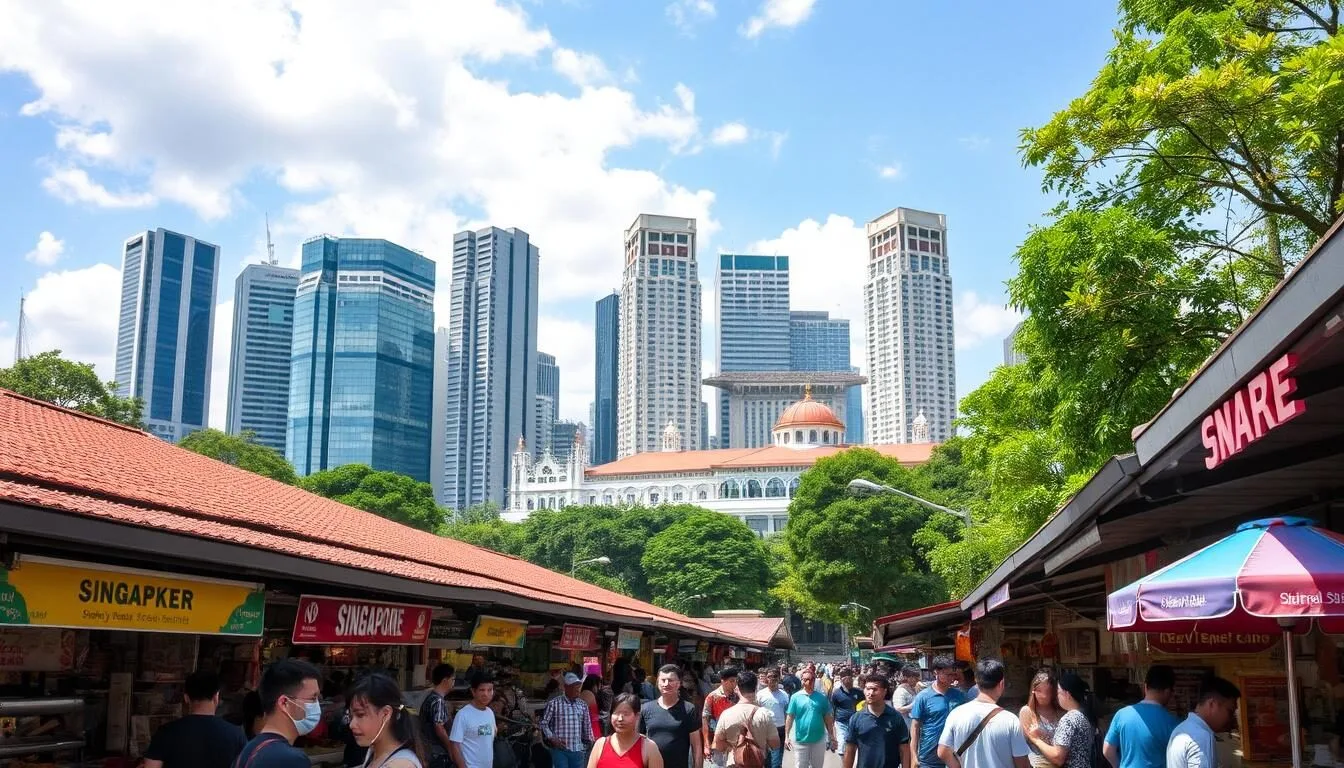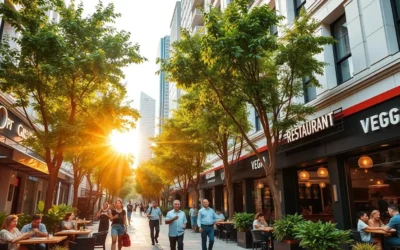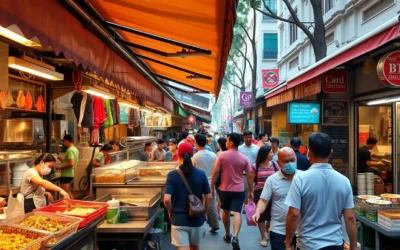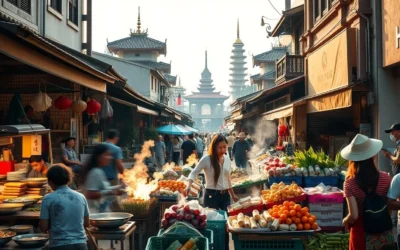Imagine a city where food is not just a necessity, but a way of life. In Singapore, the culinary scene is a vibrant tapestry of Chinese, Malay, and Indian influences, making it one of the world’s most exciting destinations for food enthusiasts.
From humble hawker stalls to high-end restaurants, Singapore’s acclaimed local-cuisine establishments serve authentic flavors that will tantalize your taste buds. You’ll discover signature dishes like Hainanese chicken rice, chili crab, and laksa that have put Singapore on the global culinary map.
Whether you’re a first-time visitor or a returning food enthusiast, this comprehensive guide will take you through Singapore’s must-visit food establishments, helping you navigate the city’s rich and diverse food landscape.
The Rich Culinary Heritage of Singapore
As a cosmopolitan city, Singapore boasts a culinary heritage that is both diverse and rich. The city-state’s strategic location and history of immigration have contributed to its unique food culture, making it a paradise for food lovers. You can experience a wide range of cuisines, from traditional street food to high-end restaurant dining.
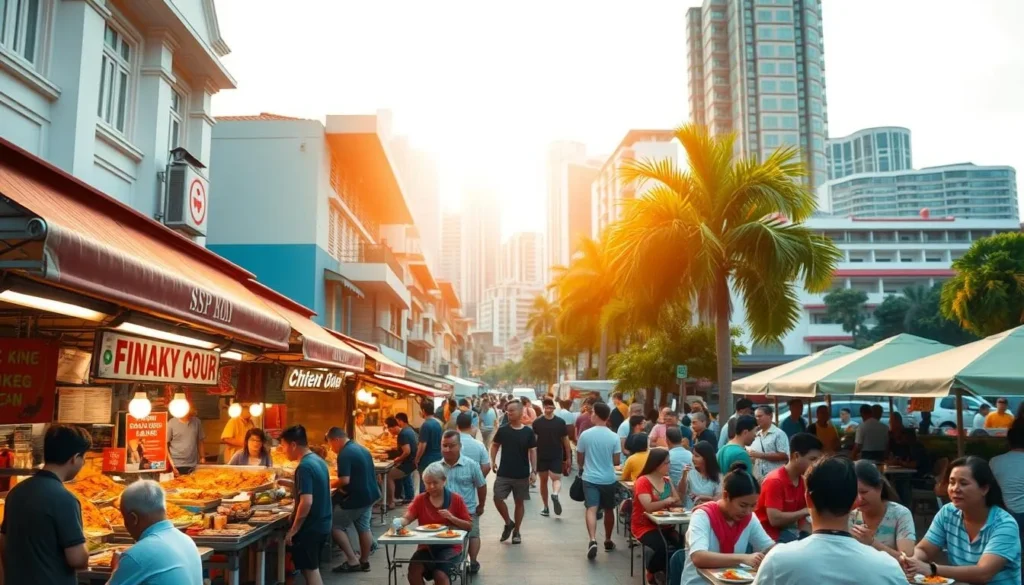
A Melting Pot of Chinese, Malay, and Indian Flavors
Singapore’s culinary identity is shaped by the diverse cultural influences of its population. The city is a melting pot of Chinese, Malay, and Indian flavors, creating a unique fusion that can’t be found anywhere else in the world. The Chinese influence brings techniques like stir-frying and steaming, while Malay cuisine contributes aromatic spices and coconut-based dishes. Indian flavors add depth with curries and flatbreads, making every meal a delightful experience.
These distinct culinary traditions have merged and evolved over decades, creating uniquely Singaporean dishes that represent the best of each culture while forming something entirely new. Local favorites like Hainanese chicken rice, laksa, and chili crab have become internationally recognized symbols of Singapore’s multicultural food identity. You can savor these dishes at various restaurants and hawker stalls throughout the city.
The Evolution of Singapore’s Food Scene
Singapore’s food scene has undergone significant transformation over the years, evolving from simple street food vendors to a sophisticated culinary landscape. The city now boasts both traditional hawker stalls and world-class restaurants, offering a diverse range of dining options for locals and tourists alike. The government’s efforts to preserve food heritage while encouraging innovation have made Singapore one of the best places in Asia for an authentic yet evolving food experience.
As you explore the city’s culinary delights, you’ll discover that the cooking techniques and ingredients used in Singaporean cuisine are a testament to its rich cultural heritage. From the bustling hawker centers to the upscale restaurants, every dining experience is a reflection of the city’s vibrant food culture. Whether you’re a food enthusiast or just looking to try something new, Singapore’s culinary scene has something to offer everyone.
Understanding Singapore’s Hawker Culture
At the heart of Singapore’s culinary scene lies its renowned hawker culture, a vibrant reflection of the city-state’s multicultural identity. Hawker centers are an integral part of Singapore’s food landscape, offering a diverse range of delicious and affordable meals.
What Are Hawker Centers?
Hawker centers are essentially food courts that house numerous stalls selling a variety of inexpensive food. These centers are communal dining spaces where people from all walks of life gather to enjoy local cuisine. Typically, a hawker center will have dozens of specialized stalls, each perfecting one or two dishes over generations, creating an unparalleled concentration of culinary expertise.
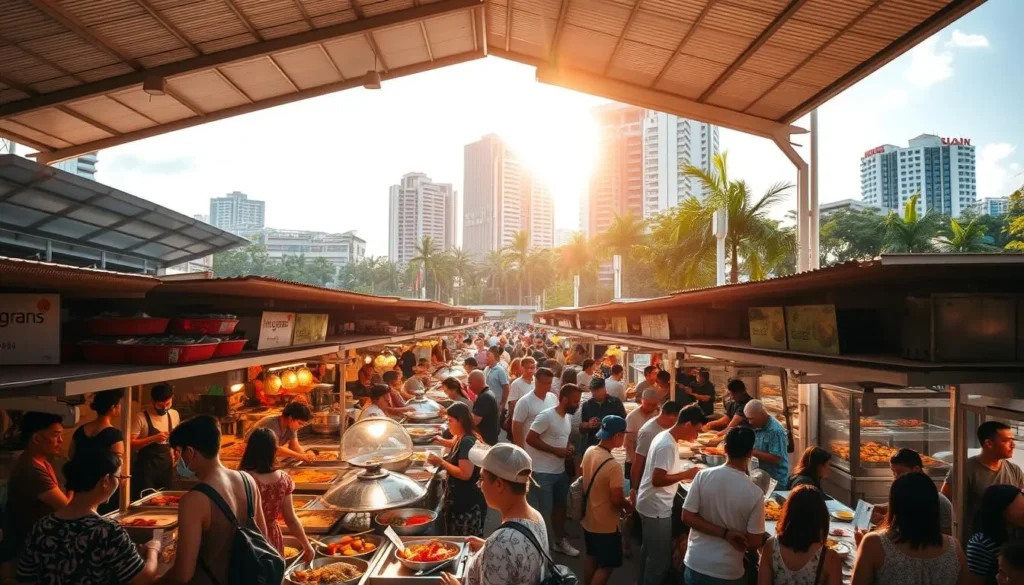
When you visit a hawker center, you’ll notice locals using the “chope” system (reserving seats with tissue packets), ordering directly from stalls, and sharing tables with strangers—all part of the authentic hawker experience. Each hawker stall specializes in specific dishes, often perfected over decades, making these humble food vendors some of the most skilled culinary experts in the city.
Hawker Center Etiquette for Visitors
To make the most of your visit to a hawker center, it’s helpful to understand the local etiquette. For instance, it’s common practice to “chope” a table by placing a packet of tissues on it. When ordering, you’ll typically order directly from the stall and pick up your food when it’s ready. Don’t be surprised if you end up sharing a table with locals or other travelers; this is all part of the communal dining experience.
The UNESCO Recognition of Singapore’s Food Culture
In 2020, Singapore’s hawker culture was added to UNESCO’s Representative List of the Intangible Cultural Heritage of Humanity, recognizing its cultural significance. This recognition officially acknowledged what locals have always known: hawker culture represents Singapore’s multicultural identity and serves as a living heritage that continues to evolve.
First-time visitors should explore popular hawker centers like Maxwell Food Centre, Chinatown Complex, and Old Airport Road Food Centre to sample the best hawker food Singapore has to offer. Whether you’re in the mood for street food, a specific dish, or just want to experience the local food culture, hawker centers are the place to be.
Maxwell Food Centre: A Treasure Trove of Local Delights
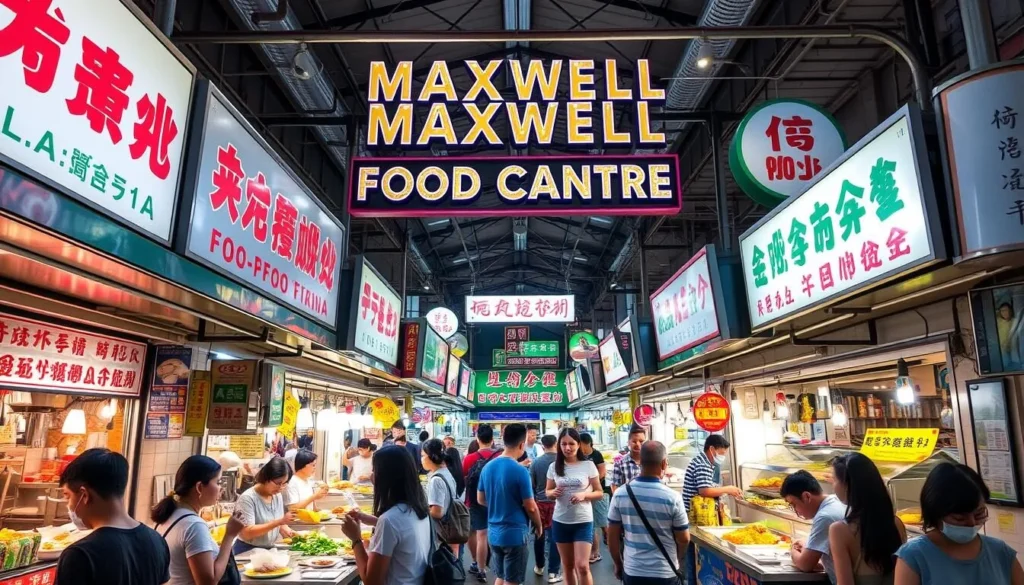
Nestled in the heart of Chinatown, Maxwell Food Centre is a culinary gem that showcases the best of Singapore’s street food. With over 100 stalls, it’s a haven for food enthusiasts looking to indulge in a variety of local delights.
Tian Tian Hainanese Chicken Rice
Tian Tian Hainanese Chicken Rice is perhaps the most famous stall at Maxwell Food Centre. Gained international recognition after Anthony Bourdain’s endorsement, it continues to draw long queues for its perfectly poached chicken and aromatic rice. The technique of plunging the chicken into ice water after cooking creates a signature tender texture, while the rice is cooked in chicken stock with ginger and pandan leaves for extra fragrance.
Jing Hua Sliced Fish Bee Hoon
Jing Hua Sliced Fish Bee Hoon offers a comforting bowl of rice noodles in a milky fish broth, topped with fresh slices of fish that are cut to order, almost like sashimi, ensuring maximum freshness. The broth has a nutty, sesame oil fragrance and is served with crispy fried shallots that add texture to this beloved dish.
Other Notable Stalls at Maxwell
Other notable stalls at Maxwell Food Centre include Maxwell Fuzhou Oyster Cake, China Street Fritters, and Maxwell Fuzhou Ancestor Bak Kut Teh. Each stall specializes in its own signature dishes, offering a diverse range of flavors and culinary experiences.
Visitors can explore these various stalls to discover the unique flavors and cooking techniques that make Maxwell Food Centre a culinary hotspot.
Chinatown Complex Food Centre: Singapore’s Largest Hawker Center
As Singapore’s largest hawker center, Chinatown Complex Food Centre is a must-visit destination for food enthusiasts looking to explore authentic Chinese flavors. With over 260 stalls across two floors, this food centre offers an overwhelming variety of local and regional Chinese specialties that cater to diverse tastes and preferences.
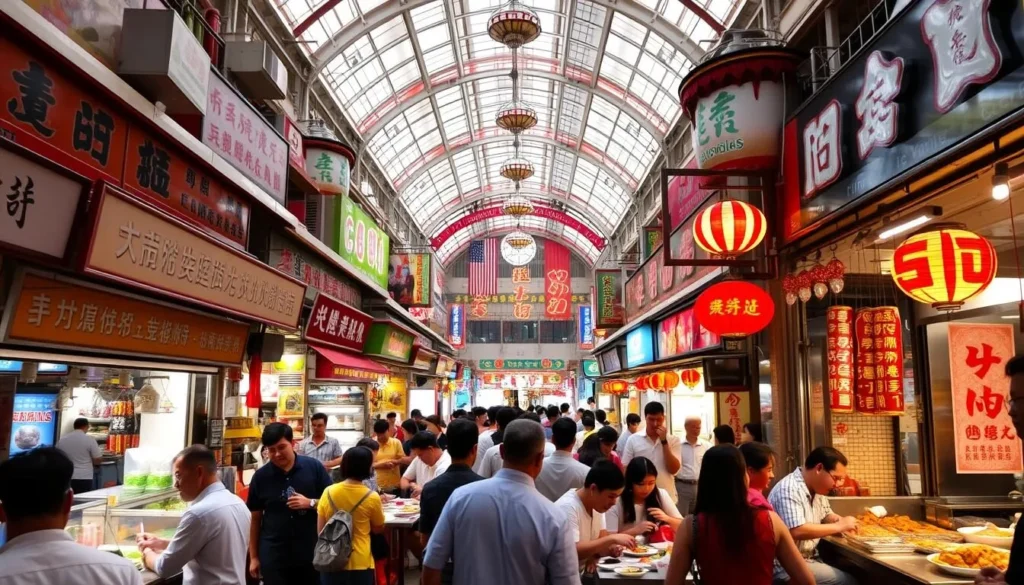
Zhong Guo La Mian Xiao Long Bao
One of the standout stalls at Chinatown Complex Food Centre is Zhong Guo La Mian Xiao Long Bao, a Michelin-recommended stall serving delicious soup dumplings with thin, silky skin. These dumplings are handmade to order, with the chef expertly pleating each one to create the perfect vessel for the rich pork soup inside—a technique that takes years to master.
Shanghai Fried Xiao Long Bao
For a different take on the classic dumpling, Shanghai Fried Xiao Long Bao offers pan-fried dumplings in shrimp, pork, and chili crab varieties. This stall brings a crispy twist to the traditional dim sum, maintaining the juicy interior while adding a satisfying crunch to the bottom.
Chinatown Fried Dough Stick
Don’t miss the simple yet satisfying Chinatown Fried Dough Stick (youtiao), a crispy Chinese cruller that’s the perfect accompaniment to congee or simply enjoyed on its own with a cup of soy milk. This classic dish is a testament to the variety of comfort food available at the centre.
In addition to these must-try stalls, Chinatown Complex Food Centre is home to numerous other notable stalls serving everything from Cantonese roast meats to hand-pulled noodles, making it a one-stop destination for exploring Chinese cuisine in Singapore. Whether you’re in the mood for a hearty dish or a light snack, this hawker centre has something for everyone.
Old Airport Road Food Centre: A Local Favorite
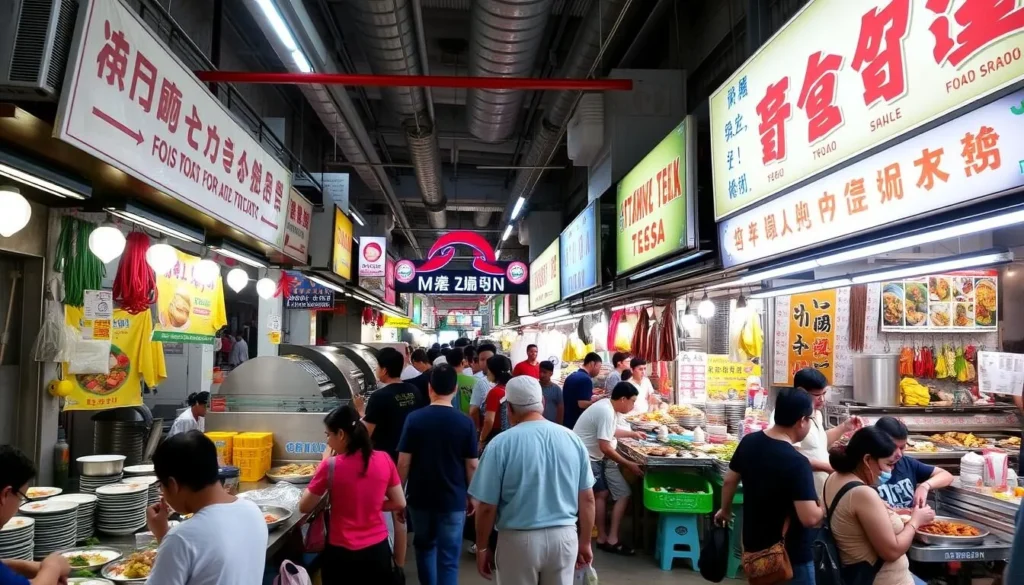
Tucked away in Singapore, Old Airport Road Food Centre is a hidden gem that locals adore. Established in 1973, this food centre has remained one of the most beloved among locals, who often claim it houses the best hawker stalls in Singapore.
Unlike more tourist-oriented food centers, Old Airport Road maintains an authentic atmosphere where you’ll find multi-generational family businesses serving time-honored recipes. The centre is home to over 100 stalls, offering a diverse range of dishes that cater to various tastes and preferences.
Nam Sing Hokkien Fried Mee
Nam Sing Hokkien Fried Mee is a legendary stall known for its flavorful noodles that are both stir-fried and steamed, creating a unique texture with plenty of broth so the noodles aren’t dry. Operating since the 1960s, Nam Sing has perfected their signature dish through a unique cooking method that combines both stir-frying and steaming the noodles under a wooden cover.
What sets Nam Sing’s Hokkien mee apart is its wetter consistency—the noodles are cooked with a flavorful broth that keeps them moist and full of flavor, complemented perfectly by a squeeze of calamansi lime. This stall is a must-visit for anyone looking to experience the authentic taste of Singapore’s hawker culture.
Other Must-Try Stalls at Old Airport Road
While Nam Sing Hokkien Fried Mee is a standout, Old Airport Road Food Centre is home to many other must-try stalls. Lao Fu Zi Fried Kway Teow, Roast Paradise for Cantonese roast meats, and Dong Ji Fried Kway Teow are just a few examples of the diverse culinary delights available.
Each of these stalls represents the pinnacle of their respective dishes, offering a culinary experience that is both authentic and delicious. Whether you’re a local or just visiting, Old Airport Road Food Centre is a great place to sample a variety of Singapore’s best hawker food.
Singapore, Singapore: Acclaimed Local-Cuisine Restaurants for Seafood Lovers
If you’re a seafood lover, Singapore is the place to be, with its numerous acclaimed restaurants serving the freshest catches. Singapore’s seafood restaurants are world-renowned, with chili crab being the national dish that every visitor should experience at least once during their stay.
Keng Eng Kee Seafood: Home of Chili Crab
Keng Eng Kee Seafood, featured on Netflix’s Street Food, serves one of the best versions of chili crab in Singapore, with the perfect balance of sweet, spicy, and tangy flavors in its signature tomato-based sauce. When ordering chili crab, don’t forget to request mantou (fried buns) to soak up the delicious sauce—the combination of crispy exterior and soft interior makes these buns the perfect vehicle for the rich crab sauce.
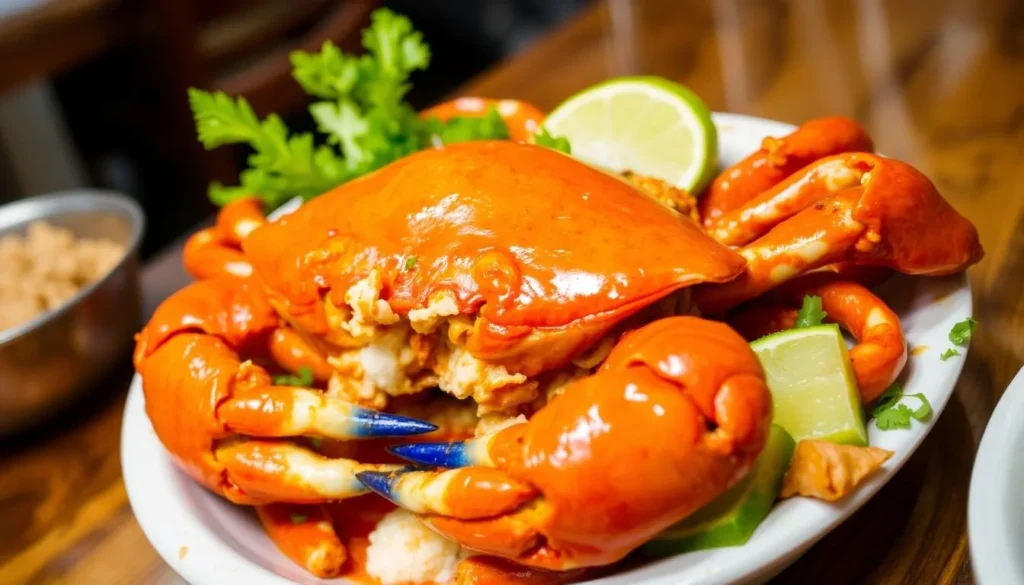
JUMBO Seafood – East Coast
JUMBO Seafood’s East Coast location offers a seaside dining experience that enhances the freshness of their seafood, with their black pepper crab providing a spicier alternative to the sweeter chili crab. The black pepper crab features a dry, intensely fragrant sauce that clings to the shell, creating a completely different but equally delicious experience compared to the saucy chili crab.
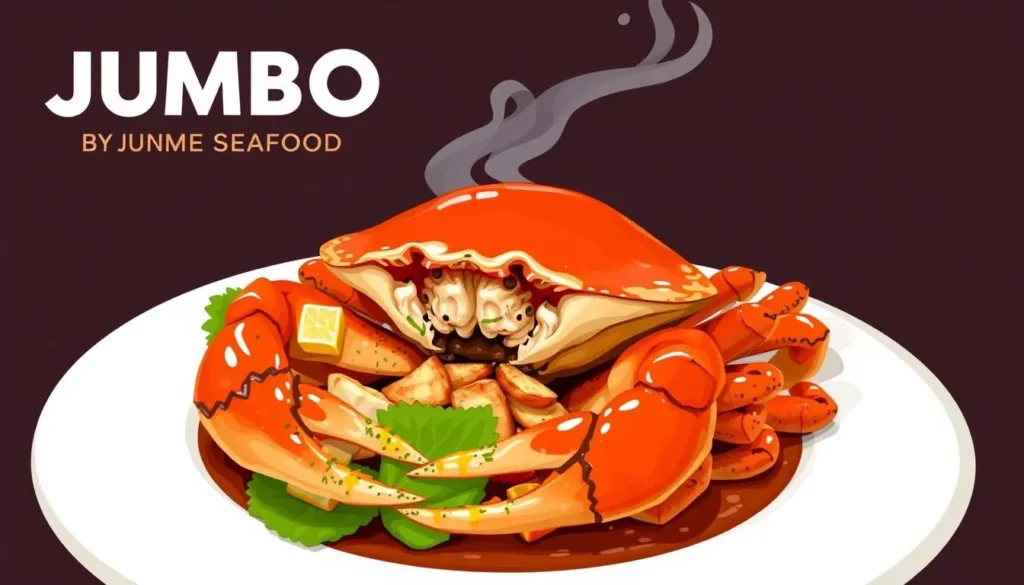
New Ubin Seafood: A Modern Take on Seafood
New Ubin Seafood stands out by combining traditional zi char (home-style Chinese cooking) with modern influences, offering innovative dishes like their signature “Heart Attack Fried Rice” cooked in beef fat alongside classic seafood preparations. This restaurant offers a unique dining experience that blends traditional flavors with modern twists.

These restaurants represent different price points and dining experiences, from the casual open-air setting of Keng Eng Kee to the more upscale ambiance of JUMBO, ensuring seafood lovers of all budgets can enjoy Singapore’s acclaimed crab dishes.
The Best Hainanese Chicken Rice in Singapore
Hainanese chicken rice is more than just a dish in Singapore; it’s a cultural icon. This beloved national dish consists of poached chicken, fragrant rice cooked in chicken broth, and accompanying dipping sauces—typically chili, ginger, and dark soy sauce. You can find Hainanese chicken rice at various hawker centers and restaurants across Singapore, each offering its unique twist on this classic dish.
Let’s dive into three of the most renowned establishments for Hainanese chicken rice: Tian Tian Hainanese Chicken Rice at Maxwell Food Centre, Yet Con Chicken Rice, and Loy Kee Best Chicken Rice. Each of these places has its loyal following and distinct characteristics that make them stand out.
Tian Tian Hainanese Chicken Rice
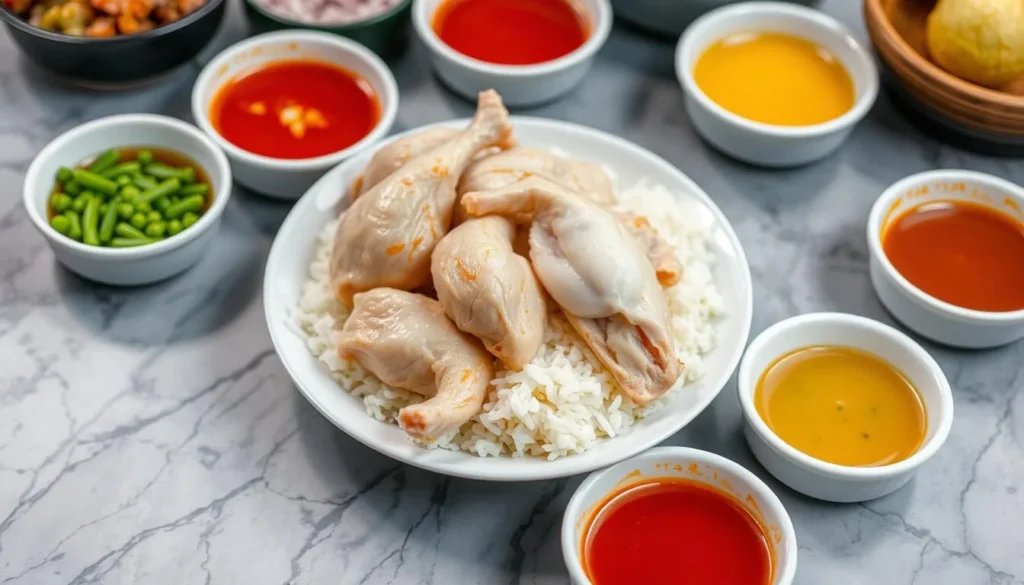
Tian Tian Hainanese Chicken Rice, located at Maxwell Food Centre, gained international fame after Anthony Bourdain’s visit. Despite its popularity with tourists, locals still consider it one of the best in Singapore. What makes Tian Tian special is their perfectly poached chicken with silky skin and the exceptionally fragrant rice that’s sticky and infused with garlic and chicken essence. Many consider the rice even better than the chicken itself.
Yet Con Chicken Rice: Old School Flavor
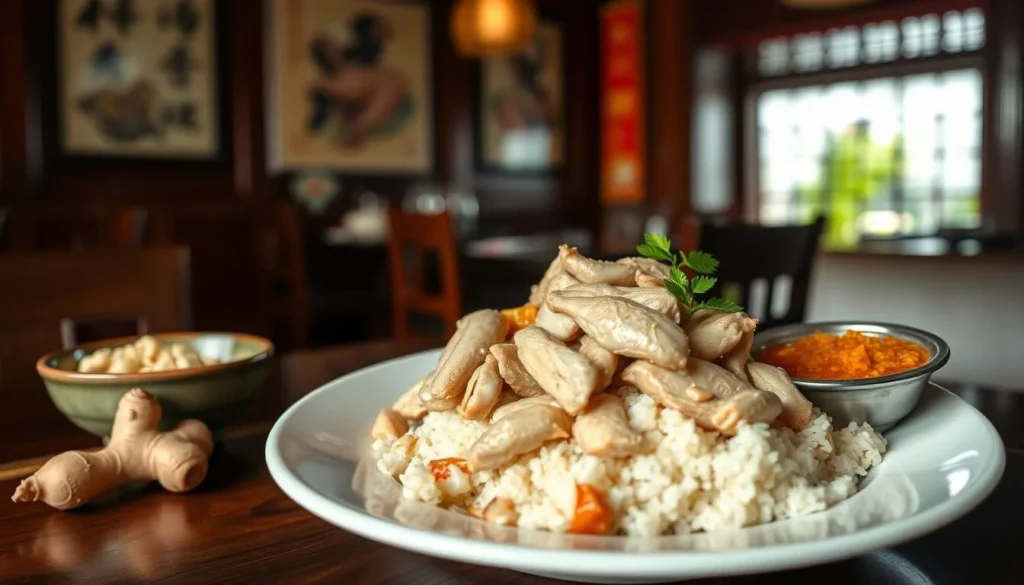
Yet Con, operating since the 1940s, offers an old-school Hainanese chicken rice experience in a traditional setting. They serve chicken that has more texture and less oil than modern versions, accompanied by an excellent ginger puree. This establishment is a must-visit for those seeking an authentic, old-school Hainanese chicken rice experience.
Loy Kee Best Chicken Rice
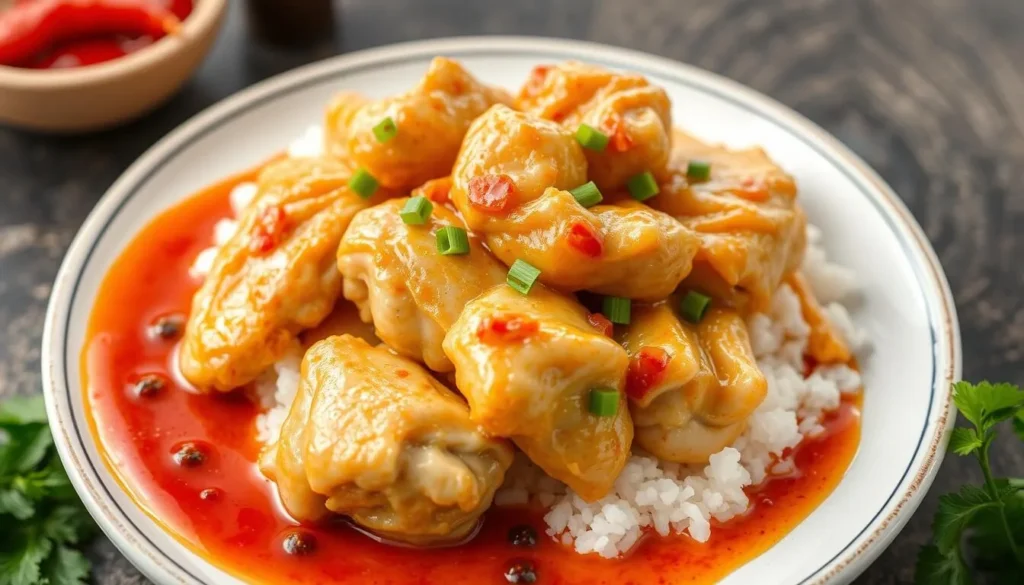
Loy Kee Best Chicken Rice, a family business running since 1953, maintains consistent quality across generations. They serve chicken that’s tender but not too soft, with a signature chili sauce that balances heat, tanginess, and garlic. This balance of flavors, along with the tender chicken and fragrant rice, makes Loy Kee a popular choice among locals and visitors alike.
Each of these establishments has its own loyal following, with preferences often coming down to the texture of the chicken, the fragrance of the rice, and the balance of flavors in the accompanying sauces. True chicken rice aficionados judge these establishments not just on the quality of the chicken, but equally on the fragrance of the rice and the punch of the accompanying chili and ginger sauces.
Laksa and Bak Kut Teh: Iconic Singapore Dishes
Laksa and bak kut teh are more than just popular dishes in Singapore; they represent the country’s diverse culinary heritage. These two soups embody the blend of Chinese and Malay flavors that characterize Singaporean cuisine.
Heritage Sungei Road Laksa
Heritage Sungei Road Laksa is renowned for its traditional cooking methods, preparing their curry in an aluminum pot over charcoal. This technique imparts a subtle smokiness to the laksa that is hard to replicate with modern cooking methods.
Their laksa features cut-up rice noodles for easier eating, a creamy coconut milk curry, blood cockles, and Vietnamese coriander. The combination creates a dish that’s more like a luxurious seafood chowder than a typical noodle soup.
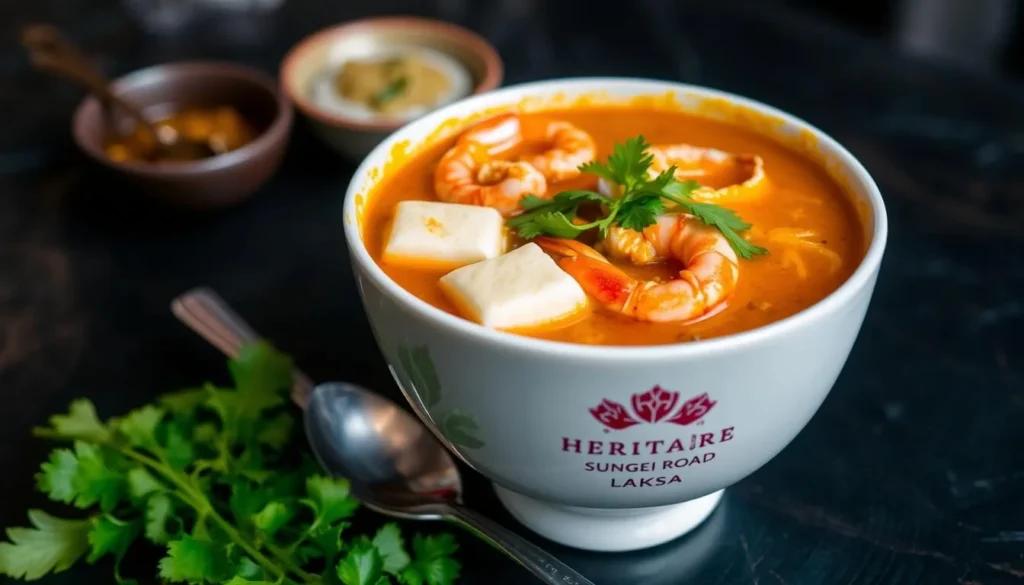
Outram Park Yahua Rou Gu Cha: Premier Bak Kut Teh
Outram Park Yahua Rou Gu Cha serves one of the best pepper-forward versions of bak kut teh. The broth is made by simmering pork ribs with white pepper, garlic, and salt until the meat becomes tender and the broth deeply flavorful.
The dish is traditionally served with rice, side dishes like preserved vegetables or braised tofu, and Chinese tea to “cut through” the richness of the pork—making it a complete meal in itself.
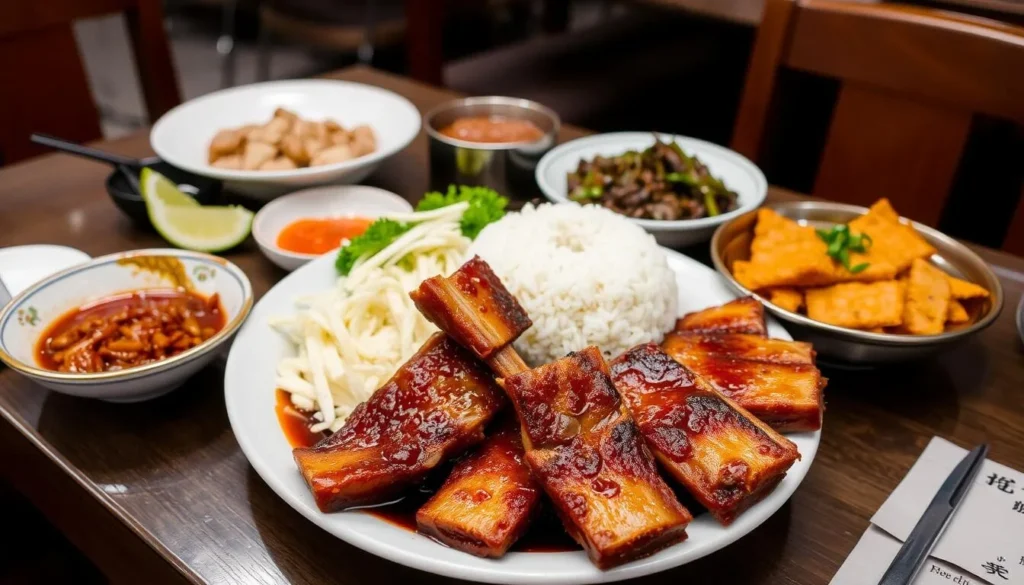
In conclusion, laksa and bak kut teh are iconic Singapore dishes that showcase the country’s culinary diversity. Whether you’re in the mood for a spicy noodle soup or a comforting pork bone tea, these dishes are sure to satisfy your cravings.
Must-Try Noodle Dishes and Where to Find Them
From bak chor mee to wanton mee, Singapore’s noodle dishes are a culinary delight. The city-state’s noodle culture is a reflection of its multicultural heritage, with various Chinese dialect groups influencing the local cuisine.
Singapore’s noodle dishes showcase the diversity of Chinese influences in local cuisine, with each variety offering distinct flavors, textures, and cooking techniques. Whether you’re a food enthusiast or just looking to try something new, these noodle dishes are sure to satisfy your cravings.
Hill Street Tai Hwa Pork Noodle: Michelin-Starred Bak Chor Mee
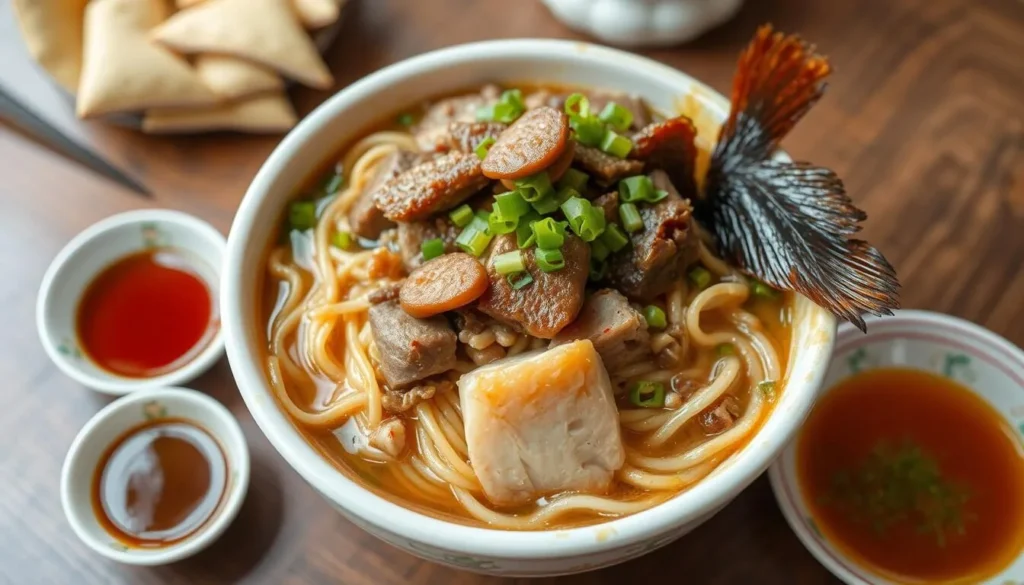
Hill Street Tai Hwa Pork Noodle serves an iconic bak chor mee (minced pork noodles) that earned a Michelin star in 2016. The dish is characterized by its perfect balance of vinegar and chili oil coating springy egg noodles, complemented by minced pork, liver, meatballs, and crispy fried sole fish.
The combination of textures and flavors makes this dish a must-try. Be prepared for a queue, as locals and tourists alike flock to this stall for a taste of its renowned bak chor mee.
Guangzhou Mian Shi Wanton Noodle

Guangzhou Mian Shi Wanton Noodle offers a delicious take on the classic Cantonese wanton mee. The dish features thin, chewy egg noodles tossed in a flavorful sauce and topped with char siu (barbecued pork) and plump dumplings filled with pork and shrimp.
Their sambal chili sauce is a highlight, adding a smoky heat and a hint of shrimp paste that elevates the simple noodle dish to something extraordinary.
Da Shi Jia Big Prawn Mee
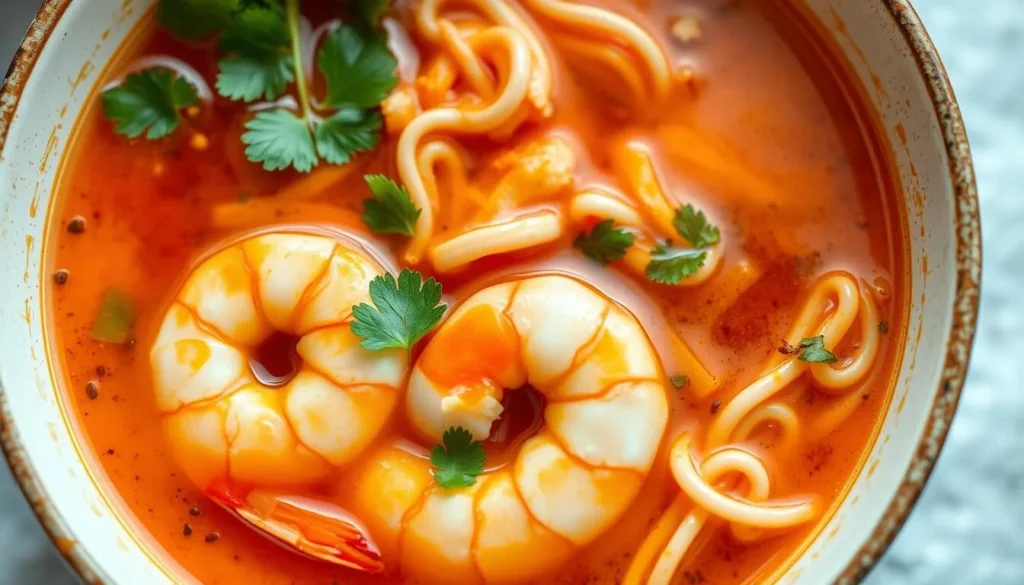
Da Shi Jia Big Prawn Mee specializes in a luxurious version of prawn noodle soup. The dish features large, fresh prawns and a rich, complex broth made from prawn heads and pork bones that have been simmered for hours.
This prawn mee is a testament to the Hokkien influence on Singapore’s noodle culture, offering a flavorful and satisfying meal that is sure to please.
Char Kway Teow and Carrot Cake: Hawker Favorites
Char kway teow and carrot cake represent the pinnacle of Singapore’s street food, requiring precision and skill to prepare. These dishes are staples in Singapore’s culinary scene, showcasing the expertise of local hawker cooks.
Char kway teow is a popular stir-fried noodle dish made with flat rice noodles, egg, dark soy sauce, shrimp paste, chili, Chinese sausage, and blood cockles. The combination of ingredients creates a complex flavor profile that is both savory and slightly sweet.
Hill Street Char Kway Teow
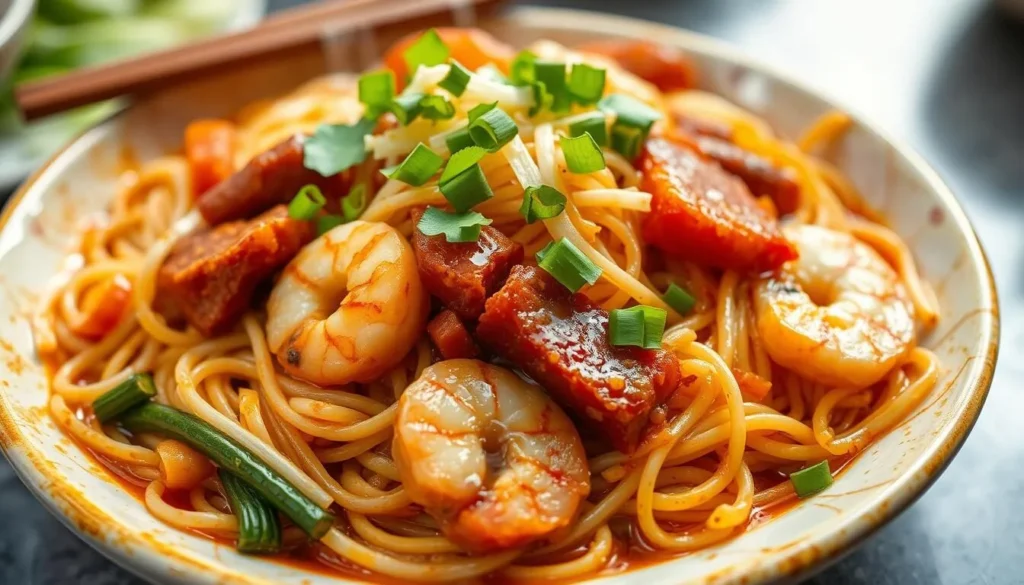
Hill Street Char Kway Teow has mastered the art of keeping the noodles moist and flavorful without becoming clumpy—a technical achievement that requires years of experience at the wok. Their char kway teow achieves the perfect balance of flavors with a slight sweetness from the dark soy sauce, umami from the shrimp paste, and freshness from the bean sprouts.
The skill in cooking char kway teow lies in achieving the perfect “wok hei” (breath of the wok), which is evident in the smoky flavor imparted by high-heat cooking. This dish is a testament to the culinary expertise found in Singapore’s hawker centers.
Song Zhou Luo Bo Gao: Best Carrot Cake
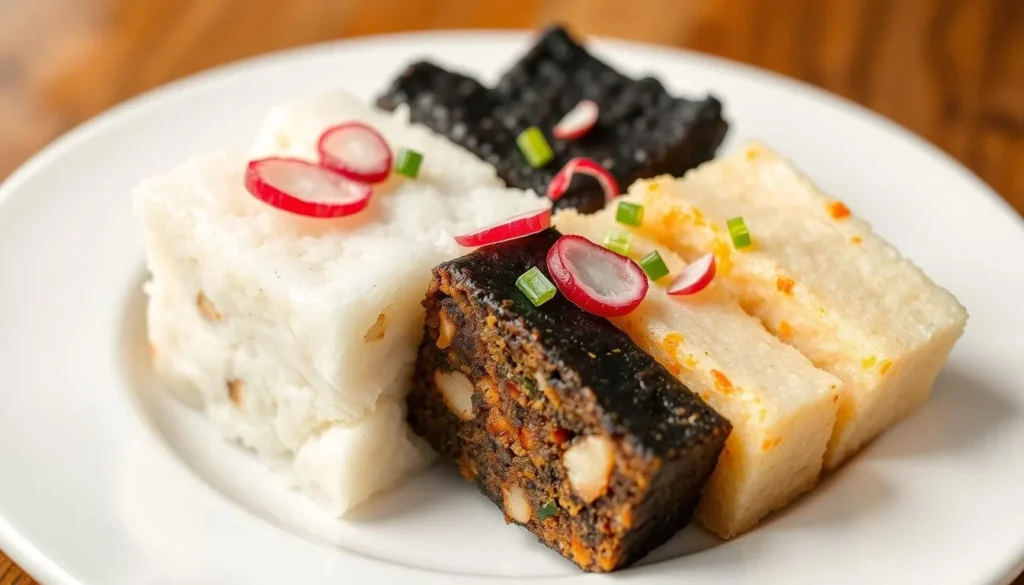
Carrot cake, or chai tow kway, in Singapore is made with daikon radish, rice flour, and eggs, not actual carrots. Song Zhou Luo Bo Gao at Bedok Interchange Food Centre serves excellent carrot cake in both black (sweet) and white (savory) versions.
The white version features more crispy edges and a cleaner taste, allowing the radish flavor to shine through. The skill in making good carrot cake lies in achieving contrasting textures—soft, slightly grainy radish cake pieces with crispy edges from the frying process, all bound together with fluffy eggs.
Both char kway teow and carrot cake are must-try dishes when visiting Singapore’s hawker centers. They embody the culinary culture and skill that define Singapore’s food scene.
Traditional Breakfast Spots in Singapore
In Singapore, breakfast is a delightful blend of local flavors and traditions. The city-state’s breakfast scene is characterized by simple yet satisfying dishes that have remained unchanged for generations.
Ya Kun Kaya Toast: Singapore’s Breakfast Institution
Ya Kun Kaya Toast, established in 1944, is a national institution that has maintained the quality of its signature kaya toast. The toast is made with crisp bread spread with coconut jam and slices of cold butter, served alongside soft-boiled eggs and a cup of strong local coffee, or kopi.
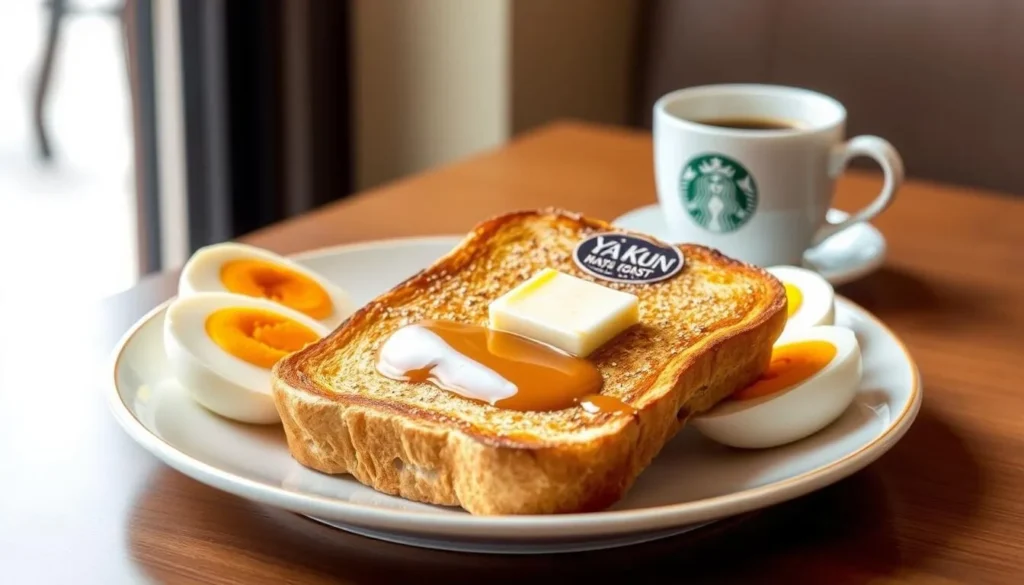
The kaya, a jam made from coconut milk, eggs, sugar, and pandan leaves, gives the toast its distinctive green color and aromatic flavor. To enjoy this breakfast, you crack the soft-boiled eggs into a saucer, season them with dark soy sauce and white pepper, and then dip the kaya toast into this savory-sweet mixture.
Killiney Kopitiam: Historic Coffee Shop
Killiney Kopitiam, operating since 1919, is one of Singapore’s oldest coffee shops. It offers a slightly different take on the traditional breakfast classics, with a richer, more coconut-forward kaya that has its devoted followers.

These breakfast institutions serve as morning gathering spots for locals from all walks of life, highlighting the democratic nature of Singapore’s food culture. Whether you’re a business executive or a construction worker, a traditional Singaporean breakfast is a meal that brings everyone together.
Acclaimed Restaurants for Authentic Chinese Cuisine
In the heart of Singapore, you’ll discover acclaimed restaurants serving authentic Chinese dishes. While hawker centers offer excellent Chinese food at affordable prices, Singapore is also home to some of the finest Chinese restaurants outside of mainland China and Hong Kong. These high-end establishments provide a sophisticated dining experience with premium ingredients and refined cooking techniques.
Imperial Treasure Super Peking Duck
Imperial Treasure Super Peking Duck represents the pinnacle of formal Chinese dining in Singapore, specializing in Beijing-style roasted duck that requires advance ordering and meticulous preparation. Their signature Peking duck is roasted to perfection in a special oven, resulting in crackling crisp skin and tender meat, then carved tableside by skilled chefs who separate the skin from the meat in the traditional way.
The duck is served in three courses: first the crispy skin with sugar for dipping, then the meat with pancakes, scallions, cucumber, and sweet bean sauce, and finally a soup made from the bones. This meticulous service ensures a truly authentic dining experience.
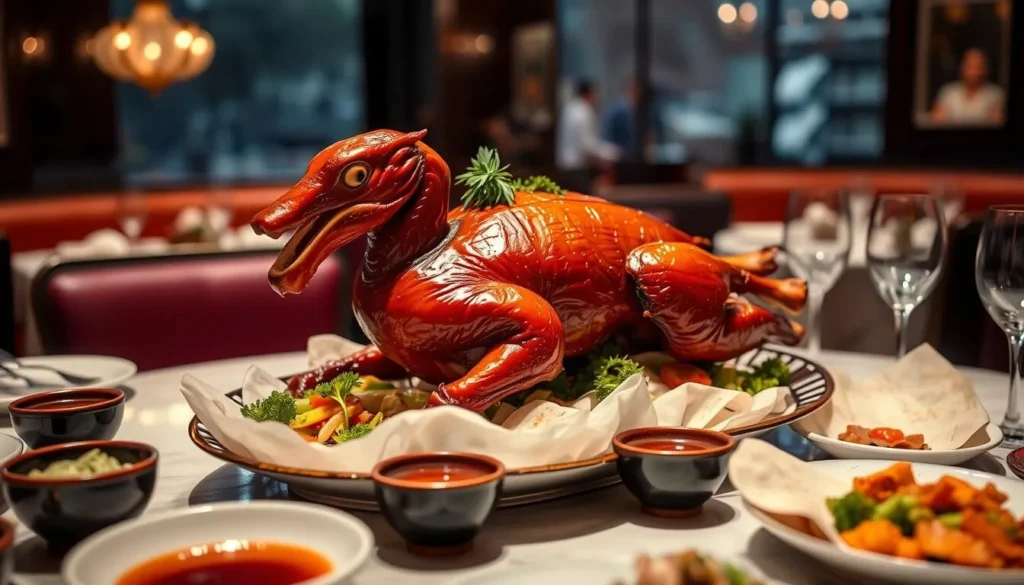
Kai Garden: Cantonese Excellence
Kai Garden showcases Cantonese cuisine at its finest, with chef Fung Chi Keung creating dishes that balance tradition with modern presentation and premium ingredients. Their dim sum menu features exquisite items like black truffle dumplings and lobster har gow, while their signature dishes include crispy roasted pork belly with perfectly crackling skin and tender meat.
The elegant setting and refined cooking techniques at Kai Garden justify its higher prices, offering a completely different dining experience from hawker centers. You can indulge in a luxurious meal that highlights the best of Cantonese cuisine.
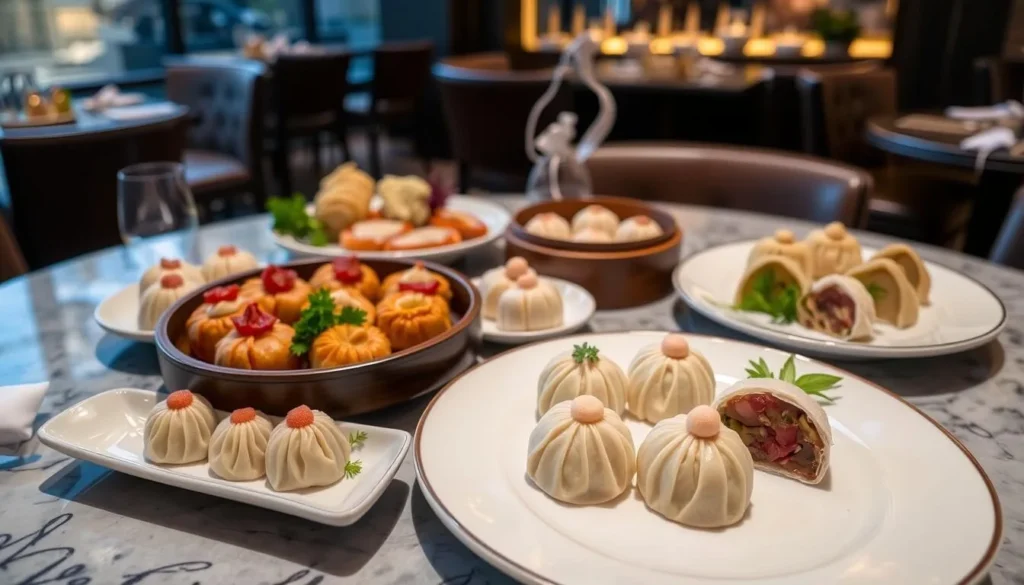
Indian and Malay Cuisine Gems in Singapore
As you explore Singapore’s diverse culinary scene, you’ll discover exceptional Indian and Malay restaurants that showcase the city’s rich cultural heritage. These cuisines have become an integral part of Singapore’s food identity, offering a wide range of flavors and dishes that cater to various tastes.
Samy’s Curry Restaurant
Samy’s Curry Restaurant has been a staple in Singapore’s culinary scene since the 1950s, serving authentic South Indian cuisine in a rustic setting at Dempsey Hill. Their signature fish head curry is a must-try, featuring a large red snapper head in a tangy tamarind-based curry sauce, accompanied by vegetables like okra and eggplant. Traditionally served on a banana leaf, this dish is meant to be savored with your hands for the full experience.
The fish head curry at Samy’s is a uniquely Singaporean-Indian creation that has made the restaurant a local institution. Alongside their signature dish, Samy’s offers a variety of other curries and dishes from different Indian regions, ensuring a diverse and satisfying meal.
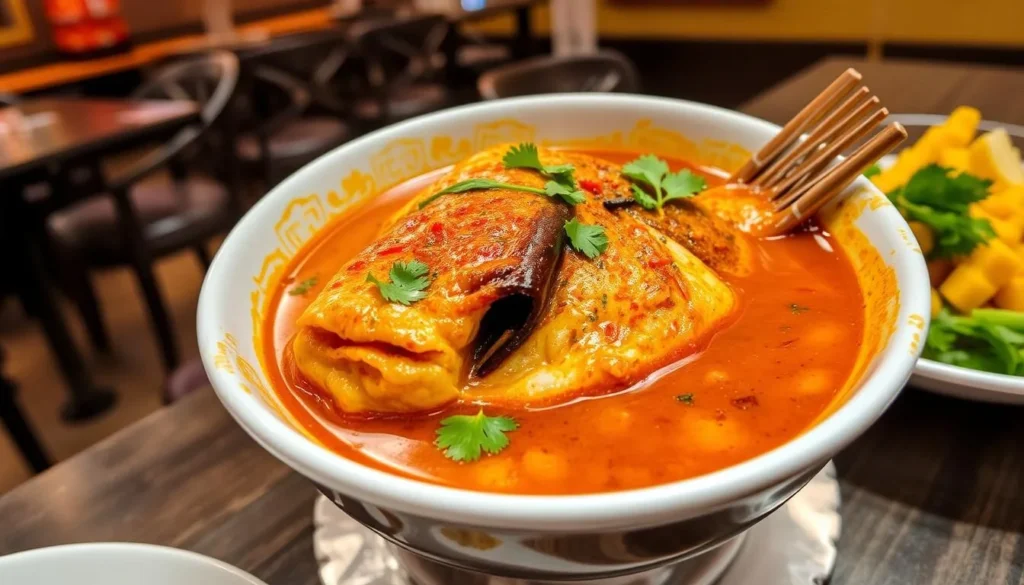
Mr & Mrs Mohgan Super Crispy Roti Prata
For those with a penchant for Indian-influenced flatbread, Mr & Mrs Mohgan Super Crispy Roti Prata is a must-visit. Their roti prata is renowned for its perfect balance of textures – simultaneously flaky, crispy, and chewy. The secret to their exceptional prata lies in the dough, which is rested for the perfect amount of time and then stretched by hand until paper-thin before being folded and cooked on a flat griddle with ghee.
Mr & Mrs Mohgan’s commitment to quality and traditional cooking methods has earned them a loyal following among locals and visitors alike. Their roti prata is best enjoyed with a side of their flavorful curry sauce, making for a delicious and satisfying meal.
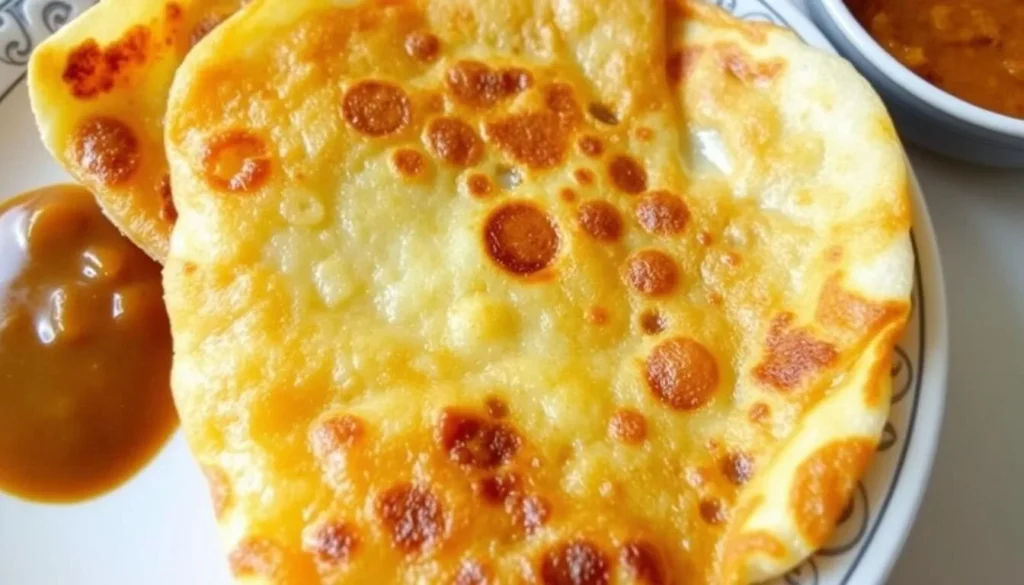
These Indian and Malay cuisine gems highlight how different culinary traditions have been adapted to local tastes while maintaining their authentic flavors, creating dishes that are now essential parts of Singapore’s food identity. As you explore these restaurants, you’ll gain a deeper appreciation for the city’s multicultural culinary landscape.
Modern Interpretations of Singaporean Cuisine
Modern interpretations of Singaporean cuisine are gaining popularity, with restaurants like Labyrinth and Burnt Ends leading the way. These innovative establishments are redefining traditional flavors through modern techniques and presentations, creating a new wave in Singapore’s dining scene.
Labyrinth: Reimagining Local Flavors
Labyrinth, helmed by Chef LG Han, has earned a Michelin star for its innovative approach to Singaporean cuisine. By transforming familiar dishes like chili crab and laksa into refined, artistic creations, Labyrinth offers a unique dining experience. The restaurant’s commitment to using 90% locally-sourced ingredients showcases the best of Singapore’s produce, despite the country’s limited farmland.
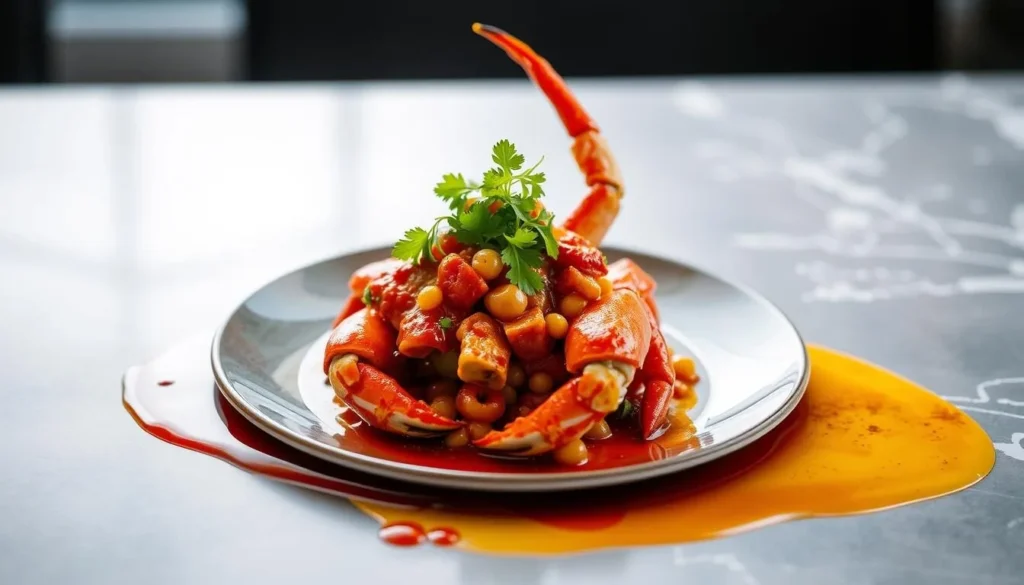
The menu at Labyrinth takes diners on a nostalgic journey through Singapore’s food heritage while pushing boundaries with modern techniques. Dishes like Ang Moh Chicken Rice and Heartland Waffle are testaments to the restaurant’s ability to blend the familiar with the innovative, creating a dining experience that’s both comforting and surprising.
Burnt Ends: Modern Australian BBQ with Local Influence
Burnt Ends, a modern Australian BBQ restaurant, has incorporated local influences into its menu, creating fusion dishes that bridge cultures through the universal language of fire and smoke. Their signature dishes, such as the bone marrow bun with sambal and the king crab with garlic butter, use local flavors and ingredients within the framework of modern wood-fired cooking.
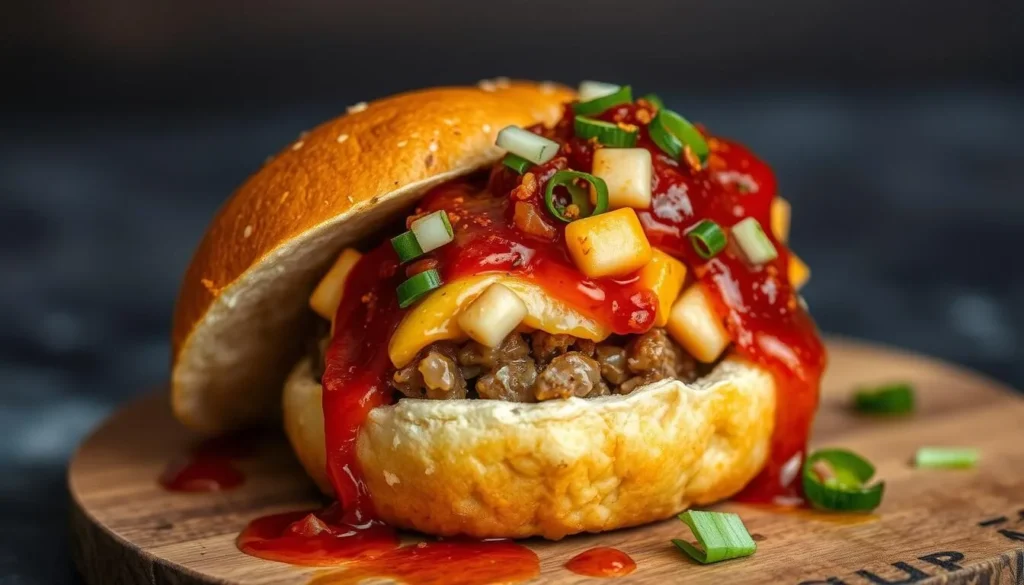
These restaurants represent one of the best aspects of Singapore’s evolving food scene—the willingness to innovate while respecting tradition. By reimagining local flavors and incorporating modern techniques, they are creating new classics that may one day be as beloved as the hawker dishes that inspired them.
Hidden Gems Off the Beaten Path
For those willing to venture beyond the usual suspects, Singapore offers a wealth of hidden culinary treasures. While many visitors flock to the famous hawker centers and acclaimed restaurants, locals know that some of the best dining experiences are found in lesser-known eateries. These hidden gems, often tucked away in quiet corners of the city, offer authentic flavors and unique dishes that are sure to delight even the most discerning food enthusiasts.
J.B. Ah Meng Restaurant
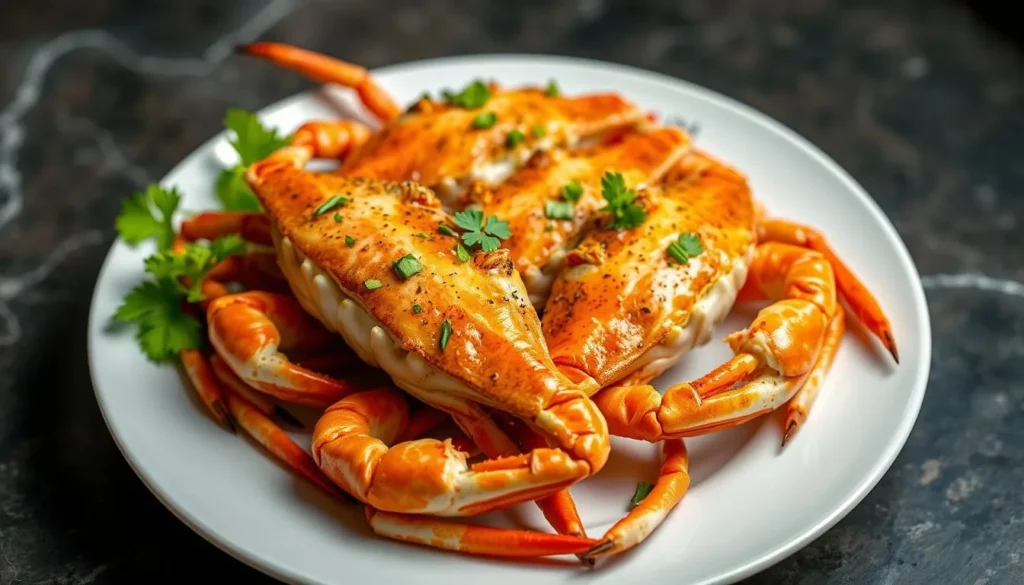
J.B. Ah Meng Restaurant, tucked away in Geylang, has gained fame among chefs and food enthusiasts for its signature white pepper crab. This lesser-known alternative to chili or black pepper crab offers a fragrant peppery heat that doesn’t overwhelm the sweetness of the crab meat. The restaurant is also known for its salted egg dishes, making it a must-visit for those looking to try something new.
Long Ji Zi Char
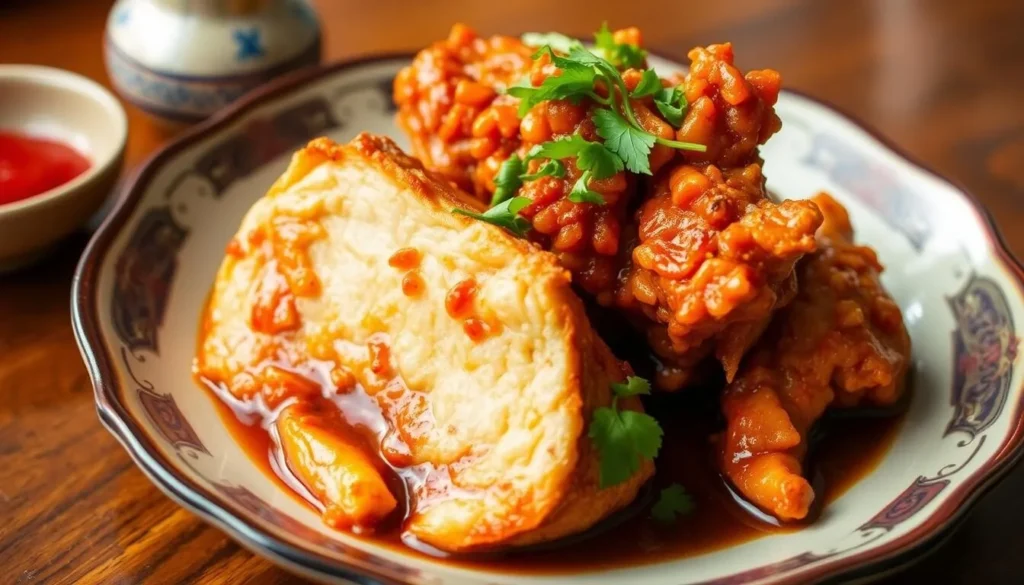
Long Ji Zi Char exemplifies the “zi char” tradition, serving home-style Chinese dishes cooked to order with unique twists. Standout dishes include their prawn paste chicken with exceptionally crispy skin and juicy meat, and coffee pork ribs with a caramelized exterior that balances sweet and savory flavors. This casual eatery is a favorite among locals and is sure to satisfy your cravings for authentic Chinese cuisine.
The Beef House
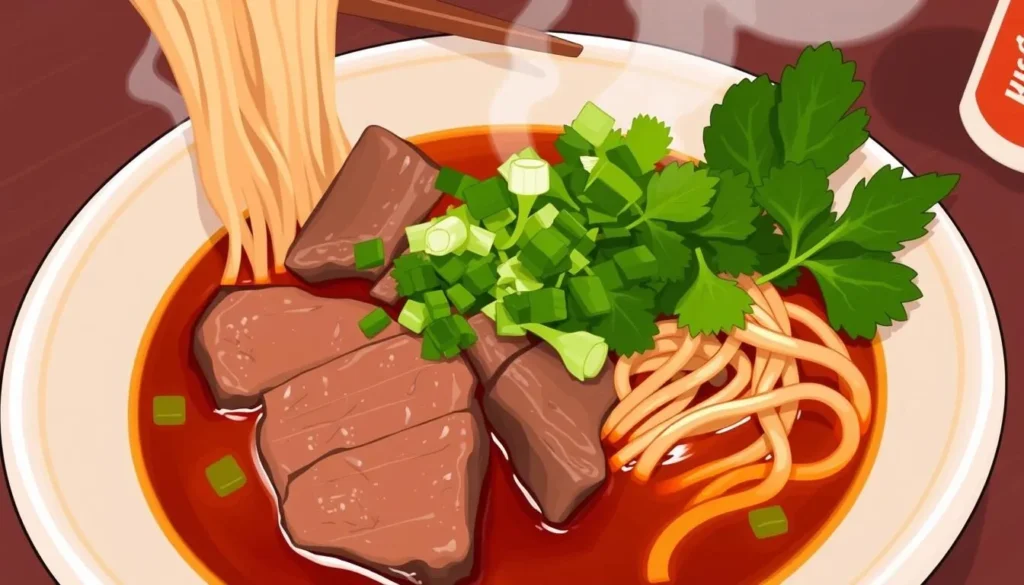
The Beef House has been serving Taiwanese-style beef noodle soup for decades, with a rich, deeply flavored broth that comes from simmering beef bones for hours. This comforting dish is a staple for locals and visitors alike, offering a taste of Taiwan in the heart of Singapore. Whether you’re a fan of beef noodle soup or just looking to try something new, The Beef House is a great place to explore.
These hidden gems may lack the polish of high-end restaurants or the fame of certain hawker stalls, but they represent the authentic, everyday dining experiences that locals treasure. By venturing off the beaten path, you can discover the true essence of Singapore’s culinary scene and enjoy meals that are both delicious and memorable.
Conclusion: Savoring the Best of Singapore’s Local Cuisine
As you conclude your culinary journey through Singapore, it’s clear that the city-state’s food scene is a true reflection of its multicultural heritage. Singapore’s culinary landscape is characterized by its diversity, with a wide range of options available to suit every taste and budget.
The city-state’s hawker centers and street food stalls offer an authentic dining experience, with popular dishes like Hainanese chicken rice and chili crab showcasing the unique flavors of Singapore. Whether you’re dining at a restaurant or a humble stall, the focus is always on using fresh ingredients and traditional cooking methods to create delicious meals.
One of the key aspects of Singapore’s food culture is its ability to evolve and adapt to changing tastes and trends. While traditional dishes remain popular, new restaurants and hawker stalls are constantly emerging, offering innovative takes on classic dishes. This blend of old and new is what makes Singapore’s food scene so exciting and dynamic.
For visitors, Singapore offers a culinary experience like no other. With its food centre and best hawker stalls, you can sample a wide range of dishes and flavors in a single meal. Whether you’re trying kaya toast for breakfast or char kway teow for dinner, you’ll discover the unique flavors and ingredients that make Singaporean cuisine so special.
As you explore Singapore’s food landscape, don’t be afraid to try new things and ask locals for recommendations. With its rich culinary heritage and diverse dining options, Singapore is a city that will leave you wanting more. Whether you’re a foodie or just looking to try something new, Singapore’s culinary scene is sure to delight and inspire you.
